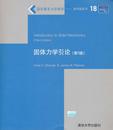固体力学引论
出版时间:2004-12 出版社:清华大学 作者:谢姆斯H.ShamesJames 页数:769
前言
随着计算机的迅速发展、有限元分析软件的广泛应用,对工程师们力学基础的要求也越来越高,然而教学学时却在不断压缩。如何改造材料力学和固体力学的教学体系和教学大纲是当今国内外都在研究的重要问题。本书在这方面进行了有益的探讨。 本书把固体力学中最基本的概念、原理和部分常用公式提取出来,尽量用概念加简明的数学推导进行讲述,不求理论上的完整性、系统性,也不要求学生掌握用解析方法求解固体力学二维、三维问题的能力,而把重点放在正确地理解概念和合理地应用基本原理及常用公式去解决工程问题。本书又包括了材料力学课程中最基本的教学内容,像是一本拓展了的材料力学教材,在学习本课程以前不必先修材料力学课程,是一本颇有特色的教材。 作者有丰富的教学经验,曾写过工程力学、固体力学、流体力学、力学中的变分方法、有限元方法等领域中的10本教材,其中有些已被国外大学所采用,并被翻译成其他语言版本。 全书共分19章,5个附录。第1章介绍基本概念和符号;第2章讲述应力基本概念和平衡微分方程;第3章讲述应变基本概念、应变一位移公式和协调方程;第4章是固体力学性质引论,包括弹性、塑性、时间相关性、疲劳、应力集中、热应力等方面;第5章讨论材料力学的一维拉压问题,包括静定、静不定问题和残余应力问题;第6章讲述广义虎克定律、应变能和卡氏第一定律,最后总结了弹性力学基本方程;第7章、第8章讲述平面应力和平面应变情况,包括两类问题的特点、坐标转换关系、主应力、主应变和莫尔圆,而不涉及弹性力学中导出和求解平面问题基本方程的内容;第9章讲述失效准则,包括最大正应力、最大正应变、最大剪应力、最大剪应变、最大畸变(歪形)能5个准则;第10章到第12章讲述材料力学的经典内容,包括梁的内力和内力矩、梁的应力和挠度;第13章用奇函数求解梁的挠度,属于选讲内容;第14章讲述圆轴和薄壁杆件的扭转问题;第15章和第16章介绍弹性力学的三维应力和应变理论,包括应力和应变性质、斜面应力公式、坐标转换关系、主应力、主应变、张量的不变量等;第17章介绍弹性稳定性问题,包括临界载荷、压杆的屈曲、纵横弯曲、偏心和初曲率的影响、非弹性情况等;第18章讲解能量法,包括位移法(虚功原理,势能原理和卡氏第一定律)和力法(余虚功原理,余能原理和卡氏第二定律),属于选讲内容。
内容概要
本书把固体力学的基本概念、基本原理和常用公式提取出来,采用物理概念加简明数学推导的讲授方法,不追求理论的完整性和系统性,不要求学生掌握用解析方法求解固体力学二维、三维问题的能力,而把重点放在正确理解概念和合理应用基本原理及常用公式去解决工程问题。 本书像一本拓展了的材料力学教材,按基础课的要求把固体力学和材料力学两者融为一体、选其精华,是一本颇有特色的教材,目前已经是第3版。作者有丰富的教学经验,曾写过不少优秀教材,本书对我国工程专业力学系列课程的教学改革具有参考意义。本书可以作为我国材料力学、工程力学和弹性力学课程的英文教材或教学参考书。
书籍目录
PrefaceAbout the Authors1 Fundamental Notions 1.1 Introduction 1.2 Fundamental Concepts 1.3 Vectors and Tensors 1.4 Force Distributions 1.5 A Note on Force and Mass 1.6 Closure 1.7 A Look Back2 Stress 2.1 Introduction 2.2 Stress 2.3 Stress Notation 2.4 Complementary Property of Shear……3 Strain4 Introduction to Mechanical Properties of Solids5 One-Dimensional Problems6 Generalized Hooke's Law and Introduction to Energy Methods7 Plane Stress8 Plane Strain9 Failure Criteria10 Section Forces in Beams11 Stresses in Beams12 Deflection of Beams13 Singularity Functions14 Torsion15 Three-Dimensional Stress Properties at a Point16 Three-Dimensional Strain Relations at a Point17 Introduction to Elastic Stability18 ENERGY METHODS19 Introduction to Finite ElementsAPPENDICESIndex
章节摘录
A cornerstone to our approach is that of making certain assumptionsand simplifications to both the structure and the analysis when neces-sary. These idealizations allow us to model the behavior of a structurein such a way as to make the equations governing its response easier touse. We will make good use of certain assumptions and simplificationsthroughout this book. We must be sure, of course, that the results of ouridealizations have some reasonable correlation with reality. Also, theidealizations may limit the usefulness of the equations we develop. It isimportant to not only understand the simplifications and assumptions,but to also recognize the limitations they place on the analysis. All ana-lytical physical sciences must resort to this technique of simplification,and, consequently, their computations are not cut and dried but involvea considerable amount of imagination, ingenuity, and insight into phys-ical behavior. We shall at this time set forth the most fundamental ide-alizations that we shall rely on in this book. The continuum. Even the simplification of matter into elemen-tary bodies such as molecules, atoms, electrons, and so on is too com-plex a picture for most problems of engineering mechanics. In mostcases we are interested only in the average measurable effects on thebody. Pressure, density, and temperature are actually the gross effectsof the actions of the many molecules and atoms. They can be conve-niently assumed to arise from a hypothetically continuous distributionof matter, that we shall call the continuum. Without such a simplifica-tion, we would have to consider the interaction of each of these ele-mentary bodies——a virtual impossibility for most engineering problems! ……
编辑推荐
按基础课的要求把固体力学和材料力学两者融为一体、选其精华。 采用物理概念加简明数学推导的讲授方法,理论、分析与应用相辅相成,反映了作者丰富的教学经验。 把重点放在正确理解概念和合理应用基本原理及常用公式去解决工程问题。不追求理论的完整性,不要求掌握解析求解固体力学问题的能力。 每章包括大量例题和习题,全部习题均有答案。
图书封面
评论、评分、阅读与下载
用户评论 (总计3条)
- 不错,英文影印版
- 看的第一本外文书,正在认真看。
- 还算是比较经典
推荐图书
- 农业管理工作指南
- 科技英语常用词用法手册
- 高等院校选用教材
- 海南岛大地构造与金成矿学
- 引力之谜//生活与科学文库
- 非线性抛物型方程
- 07八年级语文 上(江苏版课标本)-三点一测丛书-(最新修订)
- 世界兽类名称 (拉汉英对照)
- 国际标准常规分析方法大全
- 郑哲敏文集
- 九年级化学(下册)(修订版)
- 植物性神经系统生理学--基础与临床
- 启东中学高考全真演练:物理(第3轮)(2006高考必备) (平装)
- 八年级物理 上 R /启东中学作业本
- 均匀设计与均匀设计表
- 城市化与人口管理
- 启东中学高考全真演练:生物(第3轮)(2006高考必备) (平装)
- 药理学
- 心血管病学
- 区域教育可持续发展研究
- 机床数控技术及应用
- 市场调查与预测
- 龙门限时英语八年级听力训练
- 七年级语文
- 国家自然科学基金重点项目简介(二)
相关图书
- 小学生语文能力级级跳
- 课程改革的文化研究
- 高考时政热点备考专题库
- 日语基本句型用例
- 日语常用动词用例
- 学校生活日语4000句
- 社会生活日语6000句
- 管理学名校考研真题与习题解析
- 概率论与数理统计习题集
- 大学英语六级新大纲词汇 黑白记忆(书+2音带)·王长喜
- 基础汉语课本(音带)(3-4)
- 地理
- 初2几何//北京名师导学.
- 数学同步轻松练习
- 三年级·语文(下)
- 岩土植物大系统研究Ⅰ.岩土果树大系列
- 兽用抗菌药物代谢动力学研究
- 四川盆周南部高县山地灾害及防治对策研究
- 机床切削系统的颤振及其控制
- 中国层控矿床地球化学 第一卷
- 太谷核不育小麦在育种中的作用
- 天山多旋回构造演化及成矿
- 川洗地区大型经济真菌
- 图解录音技法入门
- 中国现代民间绘画 第一辑
